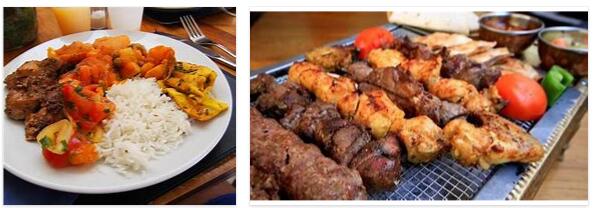The cuisine of Oman
The cuisine of Oman was originally not very varied. The desert areas and often barren soils limited the variety of dishes. Traditionally, there was mostly goat meat and, on public holidays, exceptionally meat from camels. However, the milk from camels and fish on the coasts as well as the popular dates were often on the table.
Dates are also grown in large plantations in Oman. Dates have a long shelf life and the Bedouins in particular carried them with them on their long journeys through the country as an important food. Fish was usually dried and thus preserved for a long time. One has always been dependent on foreign countries to supplement the local stocks. Therefore, spices such as cinnamon, cardamom, cloves, turmeric and others come from Asia and Africa.
What is Shoowa?
A typical Oman dish is Shoowa, which is only cooked on very festive occasions. This dish consists mainly of goat or lamb, which is wrapped in banana leaves or in date raffia and placed in the ground on glowing coals. A large hole is dug beforehand, depending on the amount of meat. The method of preparation in the earth is also found in many other cultures around the world.
The meat then stays in the pit for half a day or even a whole day until it is done. Because of the slow cooking process, it stays very tender. There is also rice, salad and limes. Many villages have such an earth oven and on festive days every resident can bring their meat and let it cook in the oven. However, it takes a little time.
Grilled meat skewers have a similar marinade and are also very popular in Oman. Another dish is hareis. It is a kind of porridge made from lamb, wheat and melted butter. Nowadays, chicken is often used instead of lamb. There is also flatbread in a thinner version.
Another popular food in Oman is called kabuli, a dish made with braised chicken or lamb, refined with spices and then sprinkled with raisins at the end.
And as a side dish: rice
Rice is an important accompaniment to many dishes in Oman. This has been imported from India for a long time and has become an important basis for nutrition in Arab cuisine.
How do you eat in Oman?
Table manners are very important throughout Arabia. Once you’ve been invited to dinner, there are a few things to keep in mind. Always wash your hands before eating. It might be the same at home.
One then wishes “Bon appetit” in Arabic. The food comes on round trays and is traditionally served on the floor. You sit around the food in a group and eat with your hands. This is why hand washing is so important. However, you should only take something from the tray where it is in front of you. The meal ends with a “Praise be to God”. This is the traditional way of eating, but Oman also has cutlery and tables where people eat. It is not uncommon for several people to eat from one large plate.
Bedouin
The Bedouins in Oman
The Bedouins live mainly in the south of Oman, a country located in Middle East according to cancermatters. They belong to the oldest tribes of Arabia. Tribal affiliation and traditions are very important to the Bedouins. The name of the family can often be used to derive the associated tribe.
The Bedouins originally lived as nomads and wandered through the deserts with their herds of cattle, always looking for new and good grazing areas for their animals. They also lived only on the products that came from the animals. They drank the milk, worked the skins and hair, and ate the meat of the animals. This was the only way they could survive in the desert, they had adapted perfectly to the local living conditions.
Hard living conditions for the people
But what sounds so romantic, it certainly wasn’t. The harsh living conditions also brought a great deal of hunger and hardship. Bedouin women held a special position. Unlike in many Muslim societies, they played an important role and, for example, managed the family’s money.
Many Bedouins can no longer lead such a life today and some things are in upheaval. Many Bedouins have settled down and have given up their nomadism. But moving about has also determined their identity. This is a difficult situation for many Bedouins.
